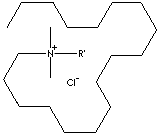| CAS NO. |
107-64-2 |

|
| EINECS NO. |
203-508-2 |
| FORMULA |
[CH3(CH2)17]2N(Cl)(CH3)2 |
| MOL WT. |
586.51 |
|
H.S. CODE
|
2923.90 |
|
TOXICITY
|
|
| SYNONYMS |
Distearyldimethylammonium chloride |
| Di(hardened tallow)dimethylammonium chloride Dimethyl distearyl ammonium chloride Dimethyldioctadecylammonium chloride Dimethyl-n-octadecyl-1-octadecanaminium chloride |
| SMILES |
|
|
CLASSIFICATION
|
|
|
PHYSICAL AND CHEMICAL PROPERTIES
|
| PHYSICAL STATE |
Light yellow paste (75%) |
|
MELTING POINT
|
|
| BOILING POINT |
100 C |
| SPECIFIC GRAVITY |
|
|
SOLUBILITY IN WATER
|
soluble |
| pH |
6 - 9 |
| VAPOR DENSITY |
|
|
REFRACTIVE INDEX
|
|
| NFPA RATINGS |
Health: 2 Flammability: 0 Reactivity: 0 |
| FLASH POINT |
|
| STABILITY |
Stable under ordinary conditions |
|
APPLICATIONS
|
|
Active Ingredient for Conditioners, Antistatic Agent, Detergent Sanitisers, softner. Distearyldimethylammonium Chloride is used in organic synthesis as a phase transfer catalyst to enhance the reaction rate of a two-phase organic-water system and as an intermediate. Quaternary ammonium salts are used for formulating antimicrobials, disinfection agents and sanitizers. It acts as a slimicidal agents and algaecide for industrial water treatment. |
| SALES SPECIFICATION |
|
BASE
|
|
APPEARANCE
|
Light yellow solid |
|
ASSAY |
98.0% min
|
|
30% SOLUTION
|
|
APPEARANCE
|
Clear mobile liquid |
| ACTIVE CONTENT |
75.0% min |
|
pH |
6.0 - 8.0 |
|
WATER |
Balance |
|
FREE AMINE |
0.8% max
|
|
FREE AMINE HCl
|
0.8% max
|
| TRANSPORTATION |
| PACKING |
100kgs in Drum |
| HAZARD CLASS |
8 (Packing Group: III) |
| UN NO. |
1759 |
| OTHER INFORMATION |
|
Hazard Symbols: XN, Risk Phrases: 22-36/37/38, Safety Phrases:
25-36/37/39-45 |
|
GENERAL DESCRIPTION OF PHASE TRANSFER CATALYSIS
|
|
'Phase transfer catalysis (PTC)' methodology is a powerful tool improving process efficiency, product selectivity and providing mild reaction conditions in organic chemical reactions. In many chemical reaction situations, there are different species (immiscible liquids or solid and liquid) which don't react each othrer due to separattion by an interface. Small quantity of ��phase-transfer catalyst��, involves a substrate (soluble in the organic layer) and an anionic reagent or a nucleophile (dissolved in the aqueous layer), extracts one of the reactants, most commonly an anion, across the interface into the other phase where reaction can take place with the substrate and reaction can proceed. The quaternary ammonium salts can carry the nucleophile from the aqueous to organic phase and are used as the most commonly used as phase-transfer catalyst. The phosphonium derivatives favoring higher thermal stability property are also used. Crown ethers and polyethylenglycol compounds are also widely used in this application. |
|
GENERAL DESCRIPTION OF DISINFECTANT |
|
Disinfectant is an agent applied to inanimate objects to destroy, neutralize, or inhibit the growth of disease-carrying microorganisms, (whereas antiseptics are applied primarily to living things). Heat and radiation are also disinfectants. Common ingredients of chemical disinfectant are: Mercuric Chlorides
Formaldehyde
8-Hydroxyquinoline
Copper Hydroxide
Cresol
Alcohols (Ethyl Alcohol Isopropyl Alcohol)
Iodines / Iodophors
Chlorine releasing compounds
Gluteraldehyde
Phenolics
Quaternary Ammonium Compounds
|
|
PRICE |
|

|
